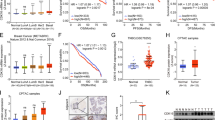Abstract
Purpose
p12CDK2-AP1 is a growth suppressor that negatively regulates cyclin-dependent kinase 2 (CDK2) activities and shows to interfere in DNA replication. Here, we aim to elucidate the role of p12CDK2-AP1 in breast cancer progression.
Methods
Expression of p12CDK2-AP1 protein was examined in 60 pairs of breast cancer specimens and adjacent non-tumor tissues using immunohistochemistry assay. Loss-of-function and gain-of-function analysis was performed on MCF-7 and MDA-MB-231 breast cancer cells. Routine assays including MTT, colony formation, flow cytometry, and tumorigenesis in nude mice were performed and cell cycle regulators were analyzed.
Results
p12CDK2-AP1 was found to be significantly downregulated in 60 breast cancer tissues compared to corresponding non-tumorous tissues. The proliferation and colony formation ability was inhibited in cells that transduced with p12CDK2-AP1 over-expression lentivirus, but enhanced in cells that transduced with p12CDK2-AP1 RNAi lentivirus. p12CDK2-AP1 over-expression led to G0/G1 phase arrest in the cell cycle and caused expression changes of cell cycle-related genes (CDK2, CDK4, p16Ink4A, p21Cip1/Waf1). Furthermore, p12CDK2-AP1 over-expression inhibited in vivo tumor growth in immunodeficiency mice, supporting an inhibitory role for p12CDK2-AP1 in breast cancer development.
Conclusions
As a cell cycle regulator, p12CDK2-AP1 is involved in the development of breast cancer and maybe a potential therapeutic candidate to suppress tumorigenicity in breast cancer.





Similar content being viewed by others
References
Bilodeau S, Roussel-Gervais A, Drouin J (2009) Distinct developmental roles of cell cycle inhibitors p57Kip2 and p27Kip1 distinguish pituitary progenitor cell cycle exit from cell cycle reentry of differentiated cells. Mol Cell Biol 29(7):1895–1908. doi:10.1128/MCB.01885-08
Choi MG, Sohn TS, Park SB, Paik YH, Noh JH, Kim KM, Park CK, Kim S (2009) Decreased expression of p12 is associated with more advanced tumor invasion in human gastric cancer tissues. Eur Surg Res 42(4):223–229
Debily MA, Marhomy SE, Boulanger V, Eveno E, Mariage-Samson R, Camarca A, Auffray C, Piatier-Tonneau D, Imbeaud S (2009) A functional and regulatory network associated with PIP expression in human breast cancer. PLoS One 4(3):e4696. doi:10.1371/journal.pone.0004696
Fassan M, D’Arca D, Letko J, Vecchione A, Gardiman MP, McCue P, Wildemore B, Rugge M, Shupp-Byrne D, Gomella LG, Morrione A, Iozzo RV, Baffa R (2011) Mitostatin is down-regulated in human prostate cancer and suppresses the invasive phenotype of prostate cancer cells. PLoS One 6(5):e19771. doi:10.1371/journal.pone.0019771
Hiyoshi Y, Watanabe M, Hirashima K, Karashima R, Sato N, Imamura Y, Nagai Y, Yoshida N, Toyama E, Hayashi N, Baba H (2009) p12CDK2-AP1 is associated with tumor progression and a poor prognosis in esophageal squamous cell carcinoma. Oncol Rep 22(1):35–39
Hu MG, Hu GF, Kim Y, Tsuji T, McBride J, Hinds P, Wong DT (2004) Role of p12(CDK2-AP1) in transforming growth factor-beta1-mediated growth suppression. Cancer Res 64(2):490–499
Jemal A, Siegel R, Xu J, Ward E (2010) Cancer statistics, 2010. CA Cancer J Clin 60(5):277–300. doi:10.3322/caac.20073
Matsuo K, Shintani S, Tsuji T, Nagata E, Lerman M, McBride J, Nakahara Y, Ohyama H, Todd R, Wong DT (2000) p12(DOC-1), a growth suppressor, associates with DNA polymerase alpha/primase. FASEB J 14(10):1318–1324
Peng H, Shintani S, Kim Y, Wong DT (2006) Loss of p12CDK2-AP1 expression in human oral squamous cell carcinoma with disrupted transforming growth factor-beta-Smad signaling pathway. Neoplasia 8(12):1028–1036
Sherr CJ, McCormick F (2002) The RB and p53 pathways in cancer. Cancer Cell 2(2):103–112
Shintani S, Ohyama H, Zhang X, McBride J, Matsuo K, Tsuji T, Hu MG, Hu G, Kohno Y, Lerman M, Todd R, Wong DT (2000) p12(DOC-1) is a novel cyclin-dependent kinase 2-associated protein. Mol Cell Biol 20(17):6300–6307
Shintani S, Mihara M, Terakado N, Nakahara Y, Matsumura T, Kohno Y, Ohyama H, McBride J, Kent R, Todd R, Tsuji T, Wong DT (2001) Reduction of p12DOC-1 expression is a negative prognostic indicator in patients with surgically resected oral squamous cell carcinoma. Clin Cancer Res 7(9):2776–2782
Sotsky Kent T, Yuan Z, Miller A, Weber TK (2004) Deleted in oral cancer-1 expression upregulates proapoptosis elements in microsatellite-unstable human colorectal cancer. Ann Surg Oncol 11(2):192–196
Todd R, McBride J, Tsuji T, Donoff RB, Nagai M, Chou MY, Chiang T, Wong DT (1995) Deleted in oral cancer-1 (doc-1), a novel oral tumor suppressor gene. FASEB J 9(13):1362–1370
Tsuji T, Duh FM, Latif F, Popescu NC, Zimonjic DB, McBride J, Matsuo K, Ohyama H, Todd R, Nagata E, Terakado N, Sasaki A, Matsumura T, Lerman MI, Wong DT (1998) Cloning, mapping, expression, function, and mutation analyses of the human ortholog of the hamster putative tumor suppressor gene Doc-1. J Biol Chem 273(12):6704–6709
Vanchieri C (2010) Making breast cancer risk assessment personal. J Natl Cancer Inst 102(13):924–926. doi:10.1093/jnci/djq261
Velasco-Velazquez MA, Li Z, Casimiro M, Loro E, Homsi N, Pestell RG (2011) Examining the role of cyclin D1 in breast cancer. Future Oncol 7(6):753–765. doi:10.2217/fon.11.56
Winchester DP (2011) Post-treatment surveillance of breast cancer patients in an organized, multidisciplinary setting. J Surg Oncol 103(4):358–361. doi:10.1002/jso.21713
Yuan Z, Sotsky Kent T, Weber TK (2003) Differential expression of DOC-1 in microsatellite-unstable human colorectal cancer. Oncogene 22(40):6304–6310
Zolochevska O, Figueiredo ML (2009) Cell cycle regulator cdk2ap1 inhibits prostate cancer cell growth and modifies androgen-responsive pathway function. Prostate 69(14):1586–1597
Conflict of interest
The authors have declared that no conflict of interest exists.
Author information
Authors and Affiliations
Corresponding author
Rights and permissions
About this article
Cite this article
Zhou, W., Guan, X., Wang, L. et al. p12CDK2-AP1 inhibits breast cancer cell proliferation and in vivo tumor growth. J Cancer Res Clin Oncol 138, 2085–2093 (2012). https://doi.org/10.1007/s00432-012-1286-z
Received:
Accepted:
Published:
Issue Date:
DOI: https://doi.org/10.1007/s00432-012-1286-z




